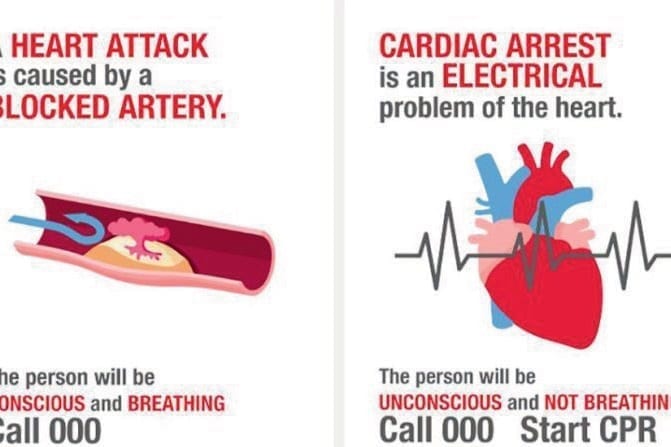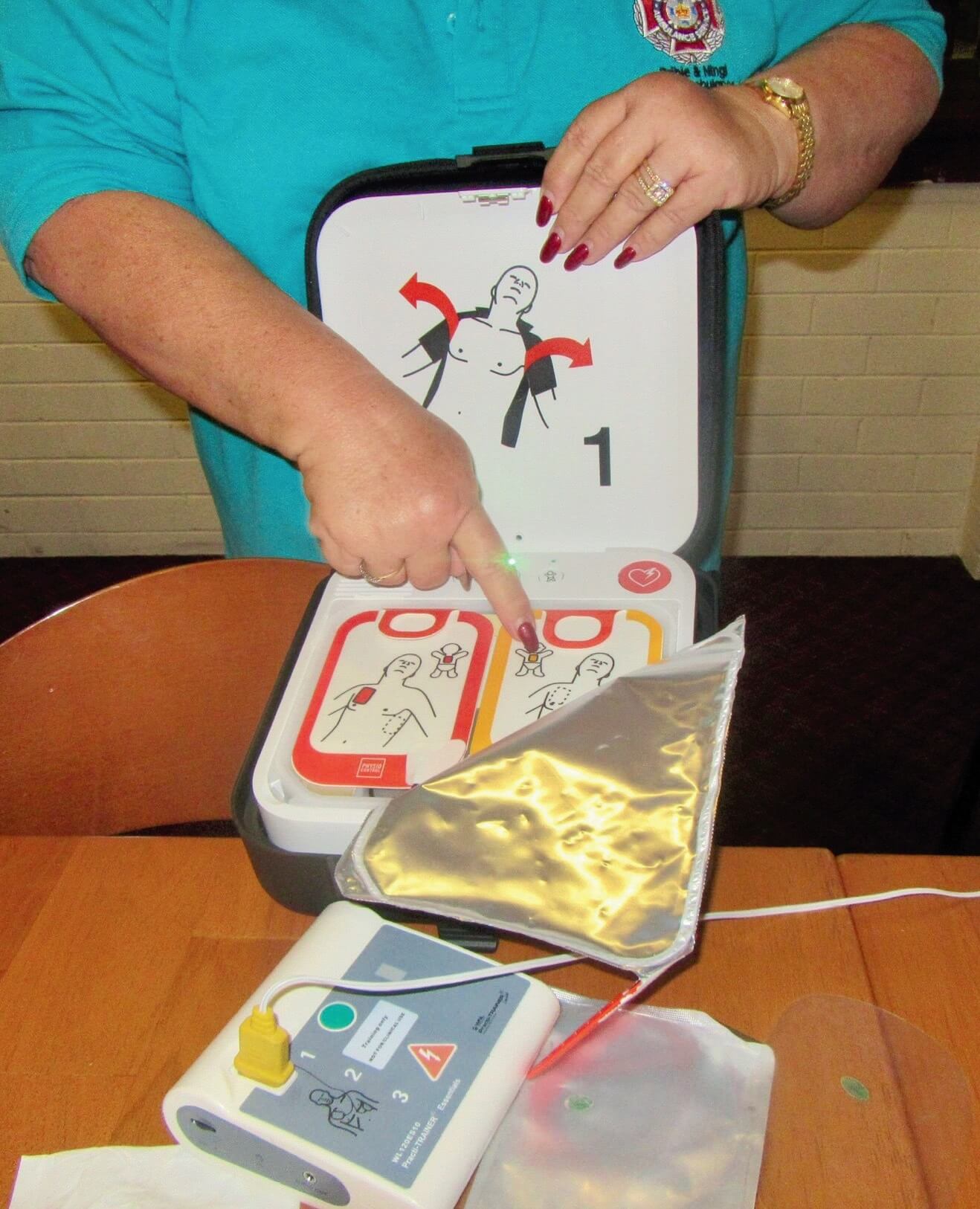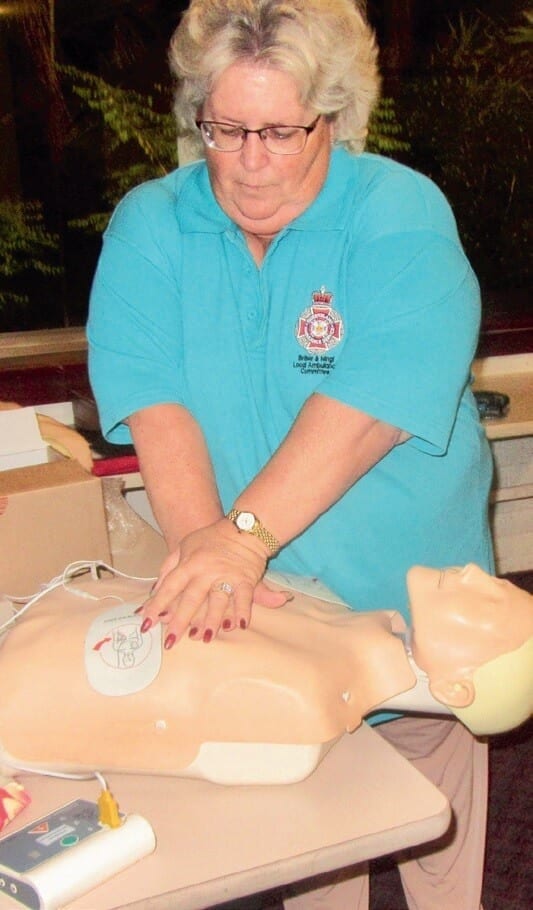Tags: Bribie Island Rotary Club. Charity. Not for profit
The Scene: You see a person clutch their chest, lose all colour in their face, and suddenly fall to the ground, unconscious, displaying no signs of life. No – it’s not a TV show or play – it’s real-life, occurring in front of you. It happens everywhere, every day, across Australia. These signs can indicate that the person is suffering from a Sudden Cardiac Arrest (SCA).
According to the National Heart Foundation, each year, more than 20,000 Australians suffer an SCA. A cardiac arrest is usually fatal and Australian medical authorities say only about 10% of those 20,000 people survive. Thus 18,000 die! St John Ambulance Australia said its figures showed the survival rate was more like 5% (19,000 deaths). No matter which statistic is correct, that is far too many lives being lost each year.
Calling 000 and giving the person immediate Cardiopulmonary Resuscitation (CPR) are the most important things to do. But if you can also quickly locate, and use a Defibrillator, this can increase their chances of survival by 70%. Saving someone’s life comes down to an issue of response time. In the interests of all Briberians, Bribie Rotary has recently purchased an Automated External Defibrillator (AED), with grant money received from “The Gambling Community Benefit Fund”, for use on the Island.
It is most important, however, to know when an AED should be used and when you should use CPR. It is also important to know if an AED is available for use, and is close by. Don’t be afraid to ask – or do a course when offered. A defibrillator is a machine that uses electricity to shock the heart back into its correct rhythm. It is used when someone has an SCA. This is when the heart suddenly stops pumping. The defibrillator analyses the heart rhythm and decides whether an electric shock is needed. AEDs can be used by almost anybody in an emergency.
They guide you through each step of the process. They won’t give the person an electric shock unless it’s necessary, so you can’t harm someone by using an AED. Last month, Bribie Rotary dedicated one of their weekly meetings to watch a demonstration on how to use a Defibrillator. The demonstration was conducted by two of our members Rae Guyder and Bernie Wilson who are also members of the Local Ambulance Committee (LAC).
I must admit that I was hesitant about using an AED, however after watching the demonstration, I realised the devices are designed to be easy to use and no “formal” training is needed. As soon as you turn the AED on it starts talking and takes you step by step through what to do. Remove all clothing between the neck and waistline, get rid of any water on the person and if necessary shave a small patch on the chest so the pads have direct contact with the skin.
Place one pad below the right shoulder and one under the heart (left ribcage). The AED will then deliver a shock that interrupts the erratic rhythm of the heart, giving it a chance to return to its normal rhythm. You should then continue CPR. The device will continue to monitor the person’s heart and if it stops again the unit will audibly advise that another shock is required. Perhaps one of the most important things to know is that a heart attack and cardiac arrest are two very different things.
A heart attack is when an artery in the heart gets blocked or becomes too narrow for blood to flow through normally. This prevents blood from getting to some parts of the heart muscle. This damages the heart, sometimes permanently. On the other hand, a cardiac arrest is when the heart suddenly stops beating. This means that the blood stops flowing to all parts of the body including the heart and brain. As soon as this happens the process of death starts. At some point, usually within 10 minutes, the damage to the heart and brain will become so great that it can’t be reversed.
The chance of survival drops by around 10% every minute after the heart stops. With a cardiac arrest, urgent treatment is required to keep the blood moving around the body and to try to ‘restart’ the heart. When CPR and AED are provided within the first few minutes the chances of survival are the greatest. AEDs are usually found in shopping centres, workplaces, sports grounds, hospitals, and gyms. This year, Woolworths is rolling them out to all its stores across Australia for the use of both workers and customers. Our Bribie Rotary AED will be located in our Rotary Market Van and will be available to anyone in need on Rotary Market Day – the second Sunday of each month.
Please let stall holders and friends know that we now have a Defibrillator. Come and see us at our next markets on Sunday 13 October and one of our dedicated team will show you where it is located. The first recorded example of shocks being used to restart a human’s heart is in 1947 by US surgeon, Claude S Beck. We have all seen ‘the paddles’ being used in movies and television shows and know how effective they can be. So if the need ever arises don’t be afraid to do something! Don’t stand back and watch, remaining one of the crowd. ACT! Time is of the essence.
If you know where the AED is – get it. Helping early is the key to life! Remember: If a defibrillator and/or CPR is used correctly within 3-5 minutes of cardiac arrest/ heart attack, survival rates jump from 5 percent to 70 percent. Perhaps 10,000+ lives can be saved. One of these lives saved might well be your Father, Mother, Uncle or Aunt. It might also be your son or daughter – don’t ever think the young are exempt! Bribie Rotary: “So much more than a Sausage Sizzle!”
Location of Defibrillators in our Area:
- Woolworths Shopping Centre
- Arts Centre
- Indoor Bowls Club
- Sandstone Pt Community Centre
- RSL
- Bribie Is Bowls Club
- Wallum Action Group
- Neighbourhood Centre
- Solander Lakes Bowls Club
- VMR Crew Room
- Life Savers Woorim
- Sandstone Pt IGA
- St Peters Church
- Orianna Village
- Rotary Van


